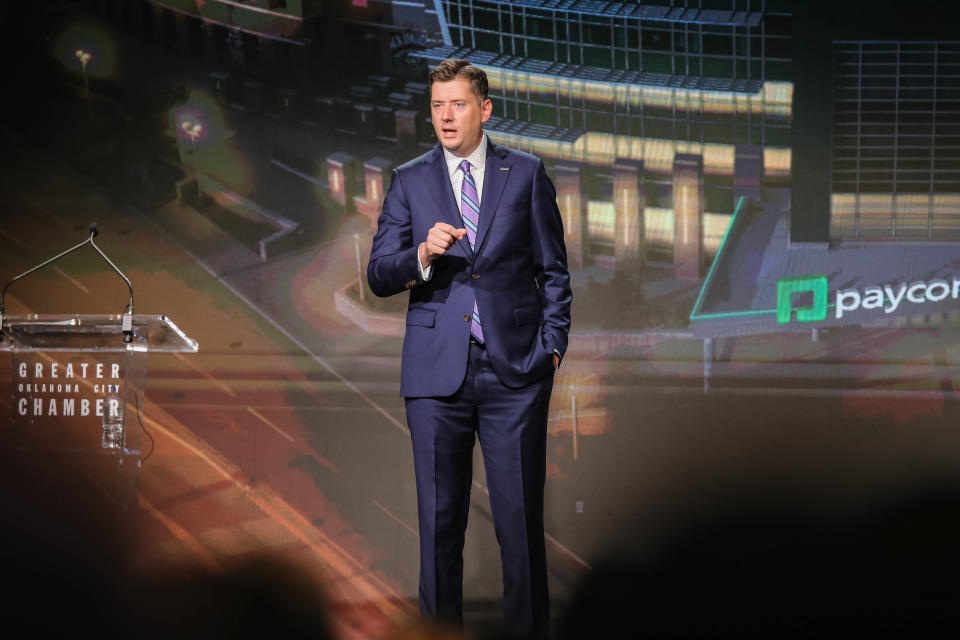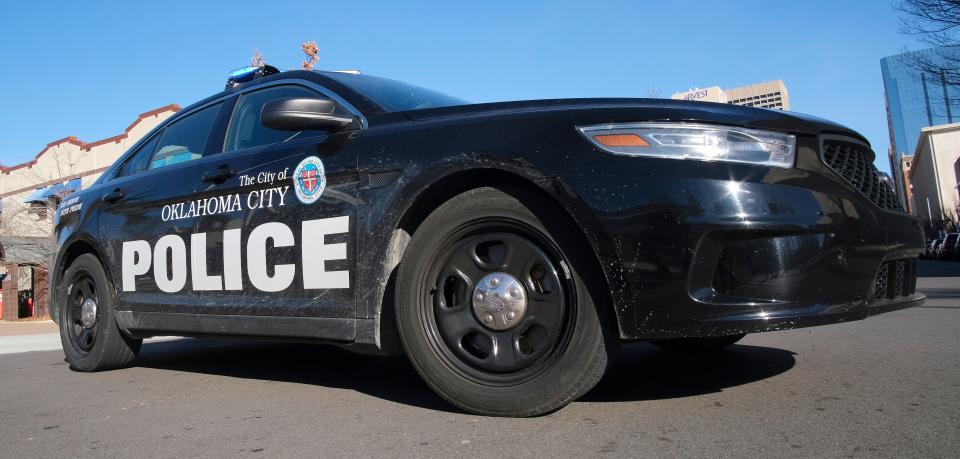How big is Oklahoma City really, and which 16 other American cities could fit inside it?
- Oops!Something went wrong.Please try again later.
What has both an urban core and rural outskirts? How about suburban neighborhoods and an Air Force base? Plus, land in four counties?
Ding, ding, ding if you guessed Oklahoma City.
Clocking in at 621 square miles, Oklahoma's capital city far outpaces most of the nation's cities when it comes to geographical size. It ranks 10th in square miles out of all U.S. cities — or third, behind Jacksonville, Florida, and Houston, Texas, when you exclude sparsely populated yet expansive municipalities in Alaska, Montana and Kansas.
The state's second-largest city by area doesn't even come close, with Tulsa sitting at just over 200 square miles, a third the size of Oklahoma City. OKC is also larger in size than some small nations, being twice the size of the Kingdom of Bahrain (303 square miles), nearly three times as large as Guam (210 square miles) and five times the size of Malta (122 square miles).
In Mayor David Holt's 2022 annual State of the City address, he said he likes to find new ways to shock residents on how large Oklahoma City really is.
More: Developers propose housing, retail for downtown OKC's I-235 gateway
That year, he named 16 cities that could fit inside Oklahoma City limits by square mileage: Berkeley, California; Alexandria, Virginia; Providence, Rhode Island; Newark, New Jersey; Fort Lauderdale, Florida; Miami, Florida; Tempe, Arizona; South Bend, Indiana; San Francisco; Boston; Anaheim, California; St. Paul, Minnesota; Minneapolis; Pittsburgh; Oakland, California; and Buffalo, New York.
As for why the mayor likes to tout the city's size in new ways, Holt said it's because he thinks an awareness is lacking both of the city's size and how that impacts services.
"I feel like nobody has told the people of Oklahoma City the very unique challenge that we face here, due to our size," Holt said. "When people come to me with concerns and disappointment about city streets, or the services that we provide border to border ... I have sensed time and again, that they don't realize that Oklahoma City is not like other cities."
Unsuspecting residents of Oklahoma City

Oklahoma City is so spread out, the city government website has an interactive map titled "Do I Live in Oklahoma City?" where folks can type in their address to see if it falls within city limits.
People can just look at their mailing address, you say? Not so. There are residents of Oklahoma City with mailing addresses in Edmond, Jones, Spencer, Yukon, Piedmont, Norman, Choctaw and Newalla. Many of those live outside of Oklahoma City's school district.
This phenomenon takes place because of the way the U.S. Postal Service assigns ZIP codes, in addition to Oklahoma City's far-reaching boundaries. Holt said there are residents on the outskirts of the city who wouldn't believe they live in Oklahoma City.
"I've often wanted to, as mayor," Holt said, "just knock on their doors and be like, 'Look! I'm your mayor! I know you can't even see Devon Tower from here. But believe it or not, I'm your mayor and I'm on your doorstep right now.'"
Christine O'zee thought she was moving from Lawton to Edmond in 2014. It wasn't until she called Edmond's utilities to turn on her water that she realized her home near NW 178 and Western was within Oklahoma City limits.
"You live in Oklahoma City," the utilities department told O'zee.
"It says here, the address is in Edmond," she argued.
"And we went back and forth for a bit and they go, 'You really have to call the city of Oklahoma City,'" O'zee said. "I expected Oklahoma City to refer me back to Edmond, because the address was in Edmond. And no, Oklahoma City was extremely helpful and set everything up for me and explained to me what the deal was."
When it came time to move again, O'zee said it was important to her to remain in Oklahoma City in order to vote in city elections and continue benefiting from the city's reliable utilities. She now lives off SW 44, with a Mustang address but within city limits.
More: Renaissance Hotel, restaurant officially open
How did Oklahoma City become so big?
How did Oklahoma City come to be so big?
The city went on what Holt called an "annexation binge" from about 1958 to 1962. In 1958, the city was 80 square miles, a figure that grew more than seven times over in the next four years. An annexation of 58 square miles in 1986 brought the city to its peak of 680 square miles. Over time, some areas were de-annexed and others have been taken on to reach 621 square miles.
The most recent significant annexation, of 160 acres at the corner of NW 206 and May, was approved by city council in 2022. More recently, the council approved the annexation of 2,600 feet of SW 149 along the boundary of Moore for a street project.
According to past articles by The Oklahoman, city leaders at the time claimed the goal of the annexation campaign was to increase the city's sales tax base. City planners said the city had good chances of having 1 million residents by 1980 if it continued with annexation, according to a 1959 article in The Oklahoman.
Stanley Draper, Oklahoma City's chamber of commerce manager in 1959, was quoted in the same article that he and other leaders were "afraid of Oklahoma City being hemmed in."
One of the more interesting annexation choices is the 320 acres of Oklahoma City that reside just inside Pottawatomie County. Annexed in 1962, the city planning director said it was at the request of one resident in the area and would keep a new city from popping up within five miles of the land, according to a story in The Oklahoman.
That sliver of Pottawatomie County remains part of Oklahoma City.
Taking care of such a large city

Mayor Holt said when it comes to providing services, the city's size is one of the biggest challenges, if not the biggest, the city faces.
Oklahoma City has over 694,000 residents ― with just over 1,100 residents per square mile ― and employs nearly 5,000 people, which comes out to eight employees per square mile. More specifically, the city has nearly two firefighters and over two police officers per square mile.
In comparison, Houston has 672 square miles, and 2.3 million residents, or 3,400 residents per square mile. The city of Houston employs 19,600, with 29 employees per square mile, six firefighters and nine police officers per square mile.
More: Oklahoma City's Pearl Beach draws thousands for volleyball, food and more
Phoenix, at 519 square miles and 1.6 million residents and 3,000 residents per square mile, employs over 15,000. That comes out to 30 employees per square mile, with four firefighters and nearly nine police officers per square mile.
"How does the city do it? I don't know," Holt said. "We just have no choice, I guess, but to carry it off ... maybe there's something to be said that people in Oklahoma City are a little more easygoing. And crime is really below other places. And maybe there is a little bit of happiness that comes with spreading out a little bit."
While residents overall say they are happy in the city's annual satisfaction survey, satisfaction is historically low when it comes to street conditions. Although, satisfaction has increased over the last few years.
Just over 16% of residents said they were satisfied with city streets in 2023, up from 14% in 2022 and 12% in 2021.
"It's not incompetence or corruption that causes us to have city streets that fall below their expectations," Holt said. "It's that we have way more city streets than everybody else, and yet we don't have more people to fund their maintenance."
While resident satisfaction may be slow to react, former Public Works Director Eric Wenger told The Oklahoman in 2022 conditions are improving. The city now spends about $100 million annually to resurface about 100 miles of roads under the 2017 Better Streets, Safer City bond program.
Over the past decade, the condition of city streets has improved from a citywide average of 63 out of 100 on the pavement condition index to 70.
The new roads have brought the number of potholes Public Works fills each year from about 80,000 to 60,000, Wenger said. Public Works has 13 crews dedicated specifically to filling potholes daily.
But with so much ground to cover, requests are fulfilled based on a prioritization system, with public safety issues fixed first.
This article originally appeared on Oklahoman: How big is Oklahoma City, and why does its size make it unique?

